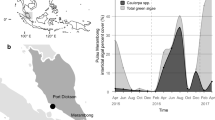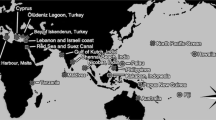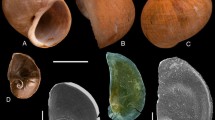Abstract
Post-Paleozoic life history transitions in mollusks and echinoderms have been biased toward switches from feeding, planktonic larvae (planktotrophic), to one of the non-feeding developmental modes, such as maternally provisioned planktonic larvae, fully encapsulated larvae, or direct development. Nevertheless, rare resurrections of feeding larvae from fully encapsulated larvae have occurred within calyptraeid and muricid gastropods. The only previous study on the developing foregut of a muricid with encapsulated larvae (Nucella lapillus) indicated loss of the larval esophagus, a potential barrier to evolutionary re-emergence of larval planktotrophy. However, histological and ultrastructural examination of foregut development in two other nucellids, Nucella lamellosa and N. ostrina, both with fully encapsulated development, revealed a transient larval esophagus in both, as identified by anatomical position, tissue composition, interconnections to other structures, and fate at metamorphosis. The larval esophagus is difficult to recognize in nucellids without a comparative framework and a complete developmental series extending from early veliger stages through to juveniles. Both the larval mouth and distal larval esophagus are completely destroyed at metamorphosis. Surprisingly, encapsulated larvae of N. lamellosa also developed all three velar ciliary tracts needed for capture and ingestion of particles, despite absence of nurse egg feeding by encapsulated larvae of this species and despite apparent absence of phytoplankton-feeding larvae in this genus since its origin 20 million years ago. Retention of a larval esophagus and a full complement of velar ciliary tracts needed for particle capture and ingestion in encapsulated larvae of some muricids may help explain how larval planktotrophy re-emerged within this clade.










Similar content being viewed by others
References
Abro AM (1969) Studies in the functional anatomy of some British monotocardian veligers, with observations on the musculature of the buccal mass of Littorina littorea (L.). Dissertation, University of Reading, Berkshire, UK
Ball AD (2002) Foregut ontogeny of the Neogastropoda: comparison of development in Nucella lapillus and Conus anemone. Boll Malacol Suppl 4:51–78
Ball AD, Andrews EB, Taylor JD (1997a) The ontogeny of the pleurembolic proboscis in Nucella lapillus (Gastropoda: Muricidae). J Mollusc Stud 63:87–99. doi:10.1093/mollus/63.1.87
Ball AD, Taylor JD, Andrews EB (1997b) Development of the acinous and accessory salivary glands in Nucella lapillus (Neogastropoda: Muricoidea). J Mollusc Stud 63:245–260. doi:10.1093/mollus/63.2.245
Bonar DB, Hadfield MG (1974) Metamorphosis of the marine gastropod Phestilla sibogae Bergh (Nudibranchia: Aeolidacea). I. Light and electron microscope analysis of larval and metamorphic stages. J Exp Mar Biol Ecol 16:227–255
Chaparro OR, Charpentier JL, Collin R (2002) Embryonic velar structure and function of two sibling species of Crepidula with different modes of development. Biol Bull 203:80–86
Cloney RA, Florey E (1968) Ultrastructure of cephalopod chromatophore organs. Z Zellforsch Mikrosk Anat 89:250–280
Collin R (2004) Phylogenetic effects, the loss of complex characters, and the evolution of development in calyptraeid gastropods. Evolution 58:1488–1502
Collin R, Chaparro OR, Winkler F, Veliz D (2007) Molecular phylogenetic and embryological evidence that feeding larvae have been reacquired in a marine gastropod. Biol Bull 212:83–92
Collins TM, Frazer K, Palmer AR, Vermeij GJ, Brown WM (1996) Evolutionary history of northern hemisphere Nucella (Gastropoda, Muricidae): molecular, morphological, ecological, and paleontological evidence. Evolution 50:2287–2304
Cowen RK, Sponaugle S (2009) Larval dispersal and marine population connectivity. Annu Rev Mar Sci 1:443–466. doi:10.1146/annurev.marine.010908.163757
Cunningham JA, Jeffery Abt CH (2009) Coordinated shifts to non-planktotrophic development in spatangoid echinoids during the Late Cretaceous. Biol Lett 5:647–650. doi:10.1098/rsbl.2009.0302
Duda RF, Palumbi SR (1999) Developmental shifts and species selection in gastropods. Proc Natl Acad Sci USA 96:10272–10277. doi:10.1073/pnas96.10272
Duda TF, Rolán E (2005) Explosive radiation of Cape Verde Conus, a marine species flock. Mol Ecol 14:267–272. doi:10.1111/j.1365-294X.2004.02397.x
Fiala JC (2005) Reconstruct: a free editor for serial section microscopy. J Microsc 218:52–61. doi:10.1111/j.1365-2818.2005.01466.x
Fioroni P (1966) Zur Morphologie und Embryogenese des Darmtraktes und der transitorischen Organe bei Prosobranchiern (Mollusca, Gastropoda). Rev Suisse Zool 73:45–875
Fretter V (1967) The prosobranch veliger. Proc Malacol Soc Lond 37:357–366
Fretter V (1969) Aspects of metamorphosis in prosobranch gastropods. Proc Malacol Soc Lond 38:375–385
Fretter V, Graham A (1994) British prosobranch gastropods. Ray Society, London
Golding RE, Ponder WF (2010) Homology and morphology of the neogastropod valve of Leiblein (Gastropoda: Caenogastropoda). Zoomorphology 129:81–91. doi:10.1007/s00435-009-0101-0
Graham A (1941) The oesophagus of stenoglossan prosobranchs. Proc R Soc Edinburgh B61:87–99
Hadfield MG, Iaea DK (1989) Velum of encapsulated veligers of Petaloconchus (Gastropoda), and the problem of re-evolution of planktotrophic larvae. Bull Mar Sci 45:377–386
Hall BK (ed) (1994) Homology. v. Academic Press, San Diego
Hall BK (2003) Descent with modification: the unity underlying homology and homoplasy as seen through an analysis of development and evolution. Biol Rev 78:409–433. doi:10.1017/S1464793102006097
Hart MW (2000) Phylogenetic analyses of mode of larval development. Sem Cell Dev Biol 11:411–418. doi:10.1006/scdb.2000.0194
Hart MW, Byrne M, Smith MJ (1997) Molecular phylogenetic analysis of life-history evolution in asterinid starfish. Evolution 51:1848–1861
Hofstee J, Pernet B (2011) Evolutionary simplification of velar ciliation in the nonfeeding larvae of periwinkles (Littorina spp.). Biol Bull 221:239–242
Hunter T, Vogel S (1986) Spinning embryos enhance diffusion through gelatinous egg masses. J Exp Mar Biol Ecol 96:303–308
Jablonski D (1986) Larval ecology and macroevolution in marine invertebrates. Bull Mar Sci 39:565–587
Jägersten G (1972) Evolution of the metazoan life cycle. Academic Press, London
Jeffery CH, Emlet RB (2003) Macroevolutionary consequences of developmental mode in temnopleurid echinoids from the Tertiary of southern Australia. Evolution 57:1031–1048
Kempf SC, Todd CD (1989) Feeding potential in the lecithotrophic larvae of Adalaria proxima and Tritonia hombergi: an evolutionary perspective. J Mar Biol Assoc UK 69:659–682
Levin LA, Bridges TS (1995) Pattern and diversity in reproduction and development. In: McEdward LR (ed) Ecology of marine invertebrate larvae. CRC, Boca Raton, pp 1–48
Lieberman BS, Allmon WD, Eldredge N (1993) Levels of selection and microevolutionary patterns in the turritellid gastropods. Paleobiology 19:205–215
Lindberg DR, Guralnick RP (2003) Phyletic patterns of early development in gastropod molluscs. Evol Dev 5:494–507. doi:10.1046/j.1525-142X.2003.03055.x
Marko PB, Palmer AR, Vermeij GJ (2003) Resurrection of Nucella ostrina (Gould, 1852), lectotype designation for N. emarginata (Deshayes, 1839), and molecular genetic evidence of Pleistocene speciation. Veliger 46:77–85
Marko PB, Moran AL, Kolotuchina NK, Zaslavskaya NI (2014) Phylogenetics of the gastropod genus Nucella (Neogastropoda: Muridicae): species identities, timing of diversification and correlated patterns of life-history evolution. J Mollusc Stud 80:341–353. doi:10.1093/mollus/eyu024
Marshall DJ, Krug PJ, Kupriyanova EK, Byrne M, Emlet RB (2012) The biogeography of marine invertebrate life histories. Annu Rev Ecol Evol Syst 43:97–114. doi:10.1146/annurev-ecolsys-102710-145004
McEdward LR (2000) Adaptive evolution of larvae and life cycles. Semin Cell Dev Biol 11:403–409. doi:10.1006/scdb.2000.0193
McEdward LR, Janies DA (1993) Life cycle evolution in asteroids: what is a larva? Biol Bull 184:255–268
McEdward LR, Janies DA (1997) Relationships among development, ecology, and morphology in the evolution of echinoderm larvae and life cycles. Biol J Linn Soc 60:381–400
Page LR (2000) Development and evolution of adult feeding structures in caenogastropods: overcoming larval functional constraints. Evol Dev 2:25–34. doi:10.1046/j.1525-142x.2000.00017.x
Page LR (2002) Larval and metamorphic development of the foregut and proboscis in the caenogastropod Marsenina (Lamellaria) stearnsii. J Morphol 252:202–217. doi:10.1002/jmor.1099
Page LR (2005) Development of foregut and proboscis in the buccinid neogastropod Nassarius mendicus: evolutionary opportunity exploited by a developmental module. J Morphol 264:327–338. doi:10.1002/jmor.10335
Page LR (2011) Metamorphic remodeling of a planktotrophic larva to produce the predatory feeding system of a cone snail (Mollusca, Neogastropoda). Biol Bull 221:176–188
Page LR, Pedersen RVK (1998) Transformation of phytoplanktivorous larvae into predatory carnivores during the development of Polinices lewisii (Mollusca, Caenogastropoda). Invert Biol 117:208–220
Pappalardo P, Rodríguez-Serrano E, Fernández M (2014) Correlated evolution between mode of larval development and habitat in muricid gastropods. PLoS One 9(4):e9104. doi:10.1371/journal.pone.0094104
Parries SC, Page LR (2003) Larval development and metamorphic transformation of the feeding system in the kleptoparasitic snail Trichotropis cancellata (Mollusca, Caenogastropoda). Can J Zool 81:1650–1661. doi:10.1139/Z03-154
Paulay G, Meyer G (2006) Dispersal and divergence across the greatest ocean region: do larvae matter? Integr Comp Biol 46:269–281. doi:10.1093/icb/icj027
Pernet B (2003) Persistent ancestral feeding structures in nonfeeding annelid larvae. Biol Bull 205:295–307
Pernet B, McHugh D (2010) Evolutionary changes in the timing of gut morphogenesis in larvae of the marine annelid Streblospio benedicti. Evol Dev 12:618–627. doi:10.1111/j.1525-142X.2010.00446x
Ponder WF, Colgan DJ, Healy JM, Nützel A, Simone LRL, Strong EE (2008) Caenogastropoda. In: Ponder WF, Lindberg DR (eds) Phylogeny and evolution of the Mollusca. University California Press, Berkeley, pp 331–383
Raff RA, Byrne M (2006) The active evolutionary lives of echinoderm larvae. Heredity 97:244–252. doi:10.1038/sj.hdy.6800866
Reid DG (1989) The comparative morphology, phylogeny and evolution of the gastropod family Littorinidae. Philos Trans R Soc Lond B 324:1–110. doi:10.1098/rstb.1989.0040
Richardson KC, Jarrett L, Fink EH (1960) Embedding in epoxy resins for ultrathin sectioning in electron microscopy. Stain Technol 35:313–323
Rivest BR (1992) Studies on the structure and function of the larval kidney complex of prosobranch gastropods. Biol Bull 182:305–323
Romero MR, Kelstrup HCP, Strathmann RR (2010) Capture of particles by direct interception by cilia during feeding of a gastropod veliger. Biol Bull 218:145–159
Scholtz G (2005) Homology and ontogeny: pattern and process in comparative developmental biology. Theor Biosci 124:121–143. doi:10.1016/j.thbio.2005.09.002
Shubin NH (1994) History, ontogeny, and evolution of the archetype. In: Hall BK (ed) Homology. The hierarchical basis of comparative biology. Academic Press, San Diego, pp 249–271
Smith AB, Littlewood DRJ, Wray GA (1995) Comparing patterns of evolution: larval and adult life-history stages and ribosomal-RNA of post-Palaeozoic echinoids. Philos Trans R Soc Lond B 349:11–18. doi:10.1098/rstb.1995.0085
Stöckmann-Bosbach R (1988) Early stages of the encapsulated development of Nucella lapillus (Linnaeus) (Gastropoda, Muricidae). J Mollus Stud 54:181–196
Stöckmann-Bosbach R, Fioroni P (1988) Quelques observations sur le développement des macromères vitellins et l’ebauche de l’intestin postérieur de Nucella lapillus L. (Gastropoda, Prosobranchia, Stenoglossa). Cah Biol Mar 29:247–259
Strathmann RR (1978) The evolution and loss of feeding larval stages in marine invertebrates. Evolution 32:899–906
Strathmann RR (1985) Feeding and nonfeeding larval development and life-history evolution in marine invertebrates. Annu Rev Ecol Syst 16:339–361
Strathmann RR (1993) Hypotheses on the origins of marine larvae. Annu Rev Ecol Syst 24:89–117
Strathmann RR, Eernisse DJ (1994) What molecular phylogenies tell us about the evolution of larval forms. Am Zool 34:502–512
Strathmann RR, Leise E (1979) On feeding mechanisms and clearance rates of molluscan veligers. Biol Bull 157:524–535
Thiriot-Quiévreux C (1969) Organogenese larvaire du genre Atlanta (Mollusque Heteropode). Vie et Milieu Sér A 20:347–396
von Werner B (1955) Über die Anatomie, die Entwicklung und Biologie des Veligers und der Veliconcha von Crepidula fornicata L. (Gastropoda Prosobranchia). Helgoländer Meeresun 5:169–217
Wray GA (1996) Parallel evolution of nonfeeding larvae in echinoids. Syst Biol 45:308–322
Wray GA, Raff RA (1991) The evolution of developmental strategy in marine invertebrates. Trends Ecol Evol 6:45–50
Acknowledgments
We thank Brent Gowen of the University of Victoria’s Electron Microscopy Laboratory for assistance with scanning electron microscopy. Funding was provided by the Natural Sciences and Engineering Research Council of Canada by way of a postgraduate scholarship to BH and a Discovery Grant (RGPIN138169-2009) to LRP.
Funding
Funding was provided by the Natural Sciences and Engineering Research Council of Canada by way of a postgraduate scholarship awarded to BH and a Discovery Grant (RGPIN138169-2009) to LRP.
Author information
Authors and Affiliations
Corresponding author
Ethics declarations
Conflict of interest
The authors declare that they have no conflict of interest.
Additional information
Responsible Editor: J. Grassle.
Reviewed by D. R. Lindberg and undisclosed experts.
Rights and permissions
About this article
Cite this article
Hookham, B., Page, L.R. How did phytoplankton-feeding larvae re-evolve within muricid gastropods? A view from developmental morphology. Mar Biol 163, 11 (2016). https://doi.org/10.1007/s00227-015-2784-8
Received:
Accepted:
Published:
DOI: https://doi.org/10.1007/s00227-015-2784-8




